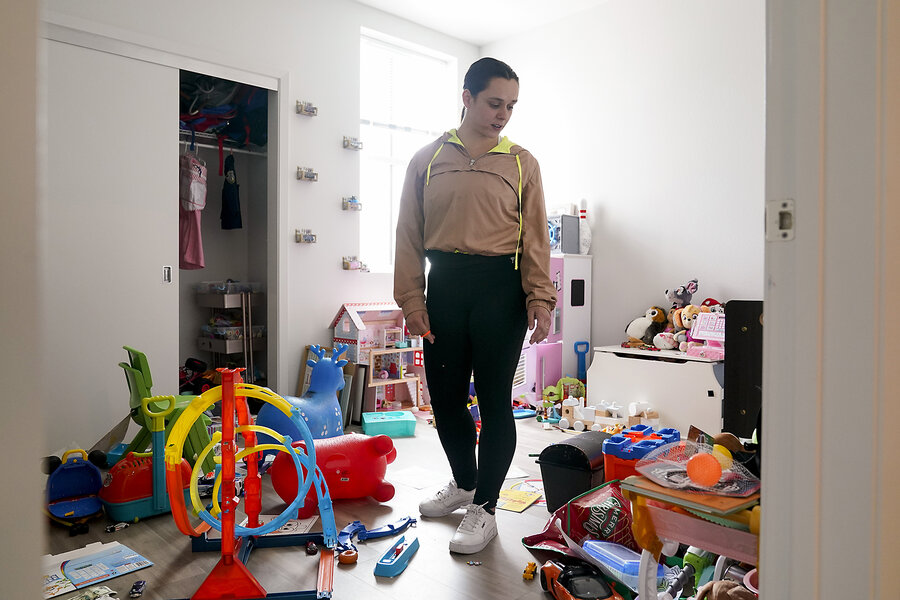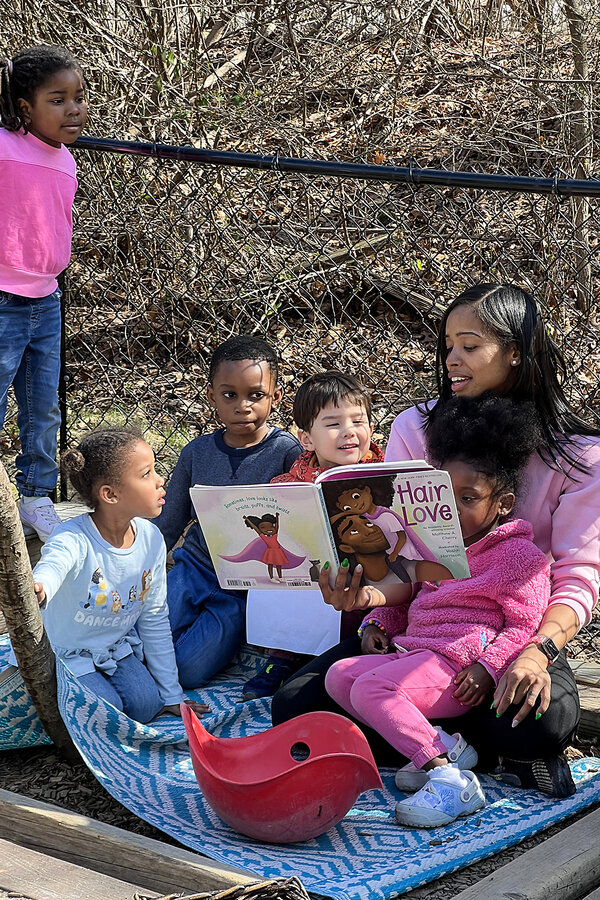There’s a new type of community being built in New Haven, just a 10-minute drive from Yale University. From the ruins of an old rock quarry, a village of multifamily houses is sprouting.
What sets it apart is whom these homes are for: Friends Center for Children is building rent-free workforce housing as a salaried benefit for employees.
Why We Wrote This
Child care in the U.S. is in crisis, with high prices for parents and low wages for child care providers. In Connecticut, one solution is to provide rent-free housing for those caring for small children.
Paris Pierce and her three children were among the first to move in. She had been spending an entire paycheck, plus half of another, on rent for a one-bedroom apartment. After groceries and utilities, she was left with close to nothing.
In their new home, she and her children have their own bedrooms. With room in her budget, she can afford extracurriculars like cheerleading for her daughter and swimming lessons for her youngest.
Workforce housing is being explored in the United States as a recruitment and retention strategy across the education sector.
“This is still an innovation and an experiment that requires further study,” says Kim Anderson, executive director of the National Education Association. She thinks it’s wise for school districts to think about benefits like workforce housing. But “there’s no substitute for a professional wage. We don’t have an absence of qualified individuals and educators in this country. We have an absence of fairly paid education jobs.”
There’s a new type of community being built in New Haven, just a 10-minute drive from Yale University. From the ruins of an old rock quarry, a village of multifamily houses is sprouting on 2 acres of land.
An open, shared courtyard will tie together the families, most of whom have young children. However, what sets this community apart is whom these homes are for. The budding village is only for child care workers. Friends Center for Children is building rent-free workforce housing as a salaried benefit for employees.
After five years working with young children, Paris Pierce was searching for ways to keep doing the work she loves. The 20-something had found her calling in caring for children under 3 years old, but her job came with challenges.
Why We Wrote This
Child care in the U.S. is in crisis, with high prices for parents and low wages for child care providers. In Connecticut, one solution is to provide rent-free housing for those caring for small children.
The mother of three was spending an entire paycheck, plus half of another, on rent for a one-bedroom apartment in New Haven. After groceries and utilities, she was left with close to nothing.
“That’s still before anything the kids might need,” adds Ms. Pierce. “We made it work, but it was tough. I was always looking for ways to make more money while staying in child care.”
Workforce housing is being explored in the United States as a recruitment and retention strategy across the education sector. However, the potential solution is so new that most evidence of its effect is still anecdotal.
In Daly City, California, a school district built a 122-unit affordable housing complex to assist its educators and staff with below-market-rate housing. In Los Angeles, the school district built three housing projects and gave leasing priority to teachers to address rising housing costs and low wages in education.
“This is still an innovation and an experiment that requires further study,” says Kim Anderson, executive director of the National Education Association, a teachers union. Ms. Anderson applauds the efforts to overcome economic barriers.
She thinks it’s wise for school districts and employers to think about other benefits like workforce housing that can be added to a professional salary. But make no mistake, “there’s no substitute for a professional wage,” says Ms. Anderson. “We don’t have an absence of qualified individuals and educators in this country. We have an absence of fairly paid education jobs.”
Still, early signs are promising. In Santa Clara, California, the unified district’s affordable housing complex – built in 2001 – has shown promising results. Since the 70-unit, below-market-rate housing opened, the attrition rate for teachers with the housing benefit has been less than one-third that of teachers with comparable experience.

Godofredo A. Vásquez/AP/File
Jefferson Union High School District administrative assistant Taylor Garcia walks through her children’s playroom in Daly City, California, July 8, 2022. The school district in San Mateo County is among those that offer educator housing.
Youngest children, least paid
The situation is even more acute for child care providers working with children under age 5.
In Connecticut, early educators with a bachelor’s degree are paid 31.3% less than their colleagues in the K-8 system, according to the Center for the Study of Child Care Employment. The poverty rate in 2020 for early educators was 14.1%, much higher than for Connecticut workers in general (7.3%) and seven times higher than K-8 teachers (2%).
In 2022, the median wage for child care workers was $14.04, up 18% since 2017, according to data from the Connecticut Department of Labor. However, the price of a one-bedroom apartment in New Haven increased nearly 30% during the same time.
Allyx Schiavone, executive director of Friends Center, says the child care sector is “woefully underfunded,” despite rising costs, with educators expected to make do with poverty-level wages. She hopes Friends Center’s Teacher Housing Initiative will serve as a model to address the nation’s crisis in both education and housing.
The initiative, started in 2021, is a means-tested program. In order to qualify for housing, a single adult must have an annual salary of $38,500 or less, or $64,000 or less for one adult with children. For a two-parent household, the ceiling is $79,000.
Child care providers pay no rent, only utilities. Tenants apply annually to continue to live in teacher housing, which is intended to help them build financial stability.
“It gives me a sense of security,” says Ms. Pierce, who was among the first to move into the village in 2021. “Because these days, support is tough to come by. So having that community backbone, for us to rely on each other, is great because it really does take a village.”

Courtesy of Friends Center for Children
Paris Pierce, an early child care provider, reads a book to her class at Friends Center for Children in New Haven, Connecticut, March 13, 2024. Ms. Pierce and her children have lived in housing provided by Friends Center since 2021.
A community effort
If it takes a village to raise a child, what does it take to raise that village? That’s something Friends Center’s building partners at Yale considered when creating teacher housing.
“We’re not trying to create a single house, but a village where a community can thrive,” says Adam Hopfner, director of the Jim Vlock building program at Yale. “We’re creating a village of sorts, whereby collective living can benefit not only the families of teachers but also the children being taught by the teachers.”
Friends Center conducted an internal survey in 2019 to understand its educators’ main financial stressors. Housing, food, transportation, and utilities were the most common concerns. The survey also revealed that of the 29 surveyed educators – mostly single women of color with children – more than three-quarters were struggling with rent. Only one owned a house.
When Friends Center launched its housing initiative, two properties were purchased with a donation from its Quaker founders. Within three months, four teachers moved in.
The tenant teachers meet with a financial adviser every month to discuss their savings goals and an emotional well-being coordinator for weekly regular check-ins.
“It takes courage to be the first of something,” says Aundrea Tabbs-Smith, the emotional well-being coordinator. “We’re trying to create something that we hope will reshape and revamp the child care system.”
Six teachers and their families currently reside in teacher housing. When the village is completed, Friends Center hopes to house 24 teachers, or 30% of its anticipated 80-teacher workforce, by 2027. In 2023, it penned a five-year agreement with the Yale School of Architecture to build four additional houses.
Each home – designed in winter and completed by fall – is created with a teacher’s needs in mind. Jessica Chen, a master’s of architecture student who helped construct the first house, drew her inspiration from “witnessing the chaos of the day firsthand” in the life of a teacher from her mother. She taught in Boston public schools for over 20 years.
“We made sure there was enough storage for all the things they need, because teachers are not only teachers in the school but also at home,” says Ms. Chen.
In Ms. Pierce’s new home, she and her children have their own bedrooms, a luxury she never enjoyed growing up. With the extra space in her budget, she can afford extracurriculars like cheerleading for her 12-year-old daughter and swimming lessons for her youngest.
Ms. Pierce’s main goal now is to build her credit so that she can purchase her own home, inspired by the one she lives in now.
>>> Read full article>>>
Copyright for syndicated content belongs to the linked Source : The Christian Science Monitor – https://www.csmonitor.com/USA/Education/2024/0325/The-US-has-a-child-care-crisis.-Can-free-housing-for-workers-help-solve-it?icid=rss































